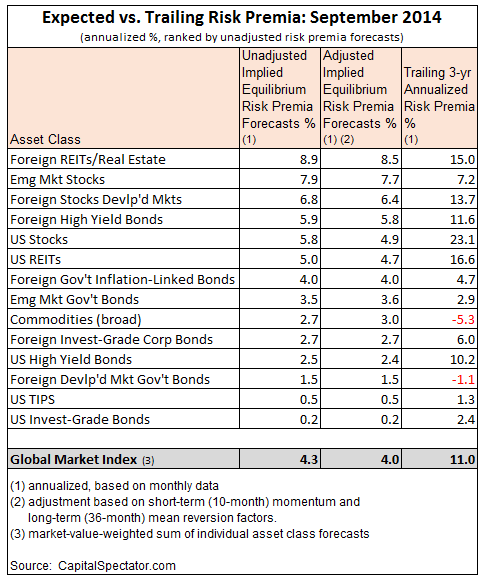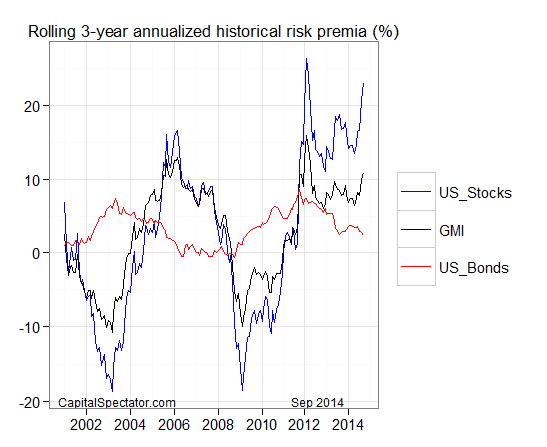The expected risk premium for the Global Market Index (GMI) dipped moderately in September vs. the previous month. GMI, an unmanaged, market-value weighted mix of the major asset classes, is currently projected to earn an annualized 4.3% over the “risk-free” rate for the long term (for details on the methodology, see summary below). Today’s forecast is below last month’s 4.7% estimate.
Adjusting for short-term momentum and longer-term mean-reversion factors (defined below) further reduces the current ex ante risk premium to 4.0% for GMI vs. the adjusted 4.2% prediction for last month’s estimate.
The current projections are quite low in comparison with the actual results in recent history. GMI’s realized risk premium is substantially higher vs. today’s forecast: 11.0% for the trailing three-year period through September 2014.
Here’s a summary of the current risk premia projections for GMI and the major asset classes:
For additional perspective on recent history, here’s a recap of rolling three-year annualized risk premia for GMI, US stocks (Russell 3000) and US Bonds (Barclays Aggregate Bond Index) for the last ten years:
Finally, here’s a brief summary of the methodology and rationale for the estimates above. The basic idea here is to reverse engineer expected return based on assumptions about risk. Rather than trying to predict returns directly, this approach relies on the somewhat more reliable model of using risk metrics to estimate performance of asset classes. The process is relatively robust in the sense that forecasting risk is slightly easier than projecting return. With the necessary data in hand, we can estimate the implied risk premia using the following inputs:
1) an estimate of GMI’s expected market price of risk, defined here as the Sharpe ratio, which is the ratio of risk premia to volatility (standard deviation).
2) the expected volatility (standard deviation) of each asset
3) the expected correlation for each asset with the overall portfolio (GMI)
The estimates above are drawn from the historical record since 1998 and are presented as a first approximation for modeling the future. The projected premium for each asset class is calculated as the product of the three inputs above. GMI’s ex ante risk premia is computed as the market-value-weighted sum of the individual projections for the asset classes.
The framework for estimating equilibrium returns was initially outlined in a 1974 paper by Professor Bill Sharpe. For a more practical-minded summary, see Gary Brinson’s explanation of the process in Chapter 3 of The Portable MBA in Investment. I also review the details in my book Dynamic Asset Allocation
. Meanwhile, here’s how Robert Litterman explains the concept of equilibrium risk premium estimates in his book Modern Investment Management: An Equilibrium Approach
:
We need not assume that markets are always in equilibrium to find an equilibrium approach useful. Rather, we view the world as a complex, highly random system in which there is a constant barrage of new data and shocks to existing valuations that as often as not knock the system away from equilibrium. However, although we anticipate that these shocks constantly create deviations from equilibrium in financial markets, and we recognize that frictions prevent those deviations from disappearing immediately, we also assume that these deviations represent opportunities. Wise investors attempting to take advantage of these opportunities take actions that create the forces which continuously push the system back toward equilibrium. Thus, we view the financial markets as having a center of gravity that is defined by the equilibrium between supply and demand. Understanding the nature of that equilibrium helps us to understand financial markets as they constantly are shocked around and then pushed back toward that equilibrium.
The adjusted risk premia estimates in the table above reflect changes based on two factors: short-term momentum and long-term mean reversion. Momentum is defined here as the current price relative to the trailing 10-month moving average. The mean reversion factor is estimated as the current price relative to the trailing 36-month moving average. The raw risk premia estimates are adjusted based on current prices relative to the 10-month and 36-month moving averages. If current prices are above (below) the moving averages, the unadjusted risk premia estimates are decreased (increased). The formula for adjustment is simply taking the inverse of the average of the current price to the two moving averages. For example: if an asset class’s current price is 10% above it’s 10-month moving average and 20% over its 36-month moving average, the unadjusted risk premium estimate is reduced by 15%.
What can you do with the forecasts in the table above? You might start by considering if the expected risk premia are satisfactory… or not. If the estimates fall short of your required return, you might consider how to engineer a higher rate of performance by way of customizing asset allocation and rebalancing rules. Keep in mind that GMI’s implied risk premia is based on an unmanaged market-value weighted mix of the major asset classes. In theory, that’s the optimal asset allocation for the average investor with an infinite time horizon. Unless you’re a foundation or pension fund, this time-horizon assumption is highly impractical and so there’s a reasonable case for a) modifying Mr. Market’s asset allocation to suit your particular needs and risk budget; and b) adding a rebalancing component to your investment strategy.
You might also estimate risk premia with alternative methodologies for additional insight about the near-term future (an excellent resource on this subject: Antti Ilmanen’s Expected Returns). For instance, let’s say that you have confidence in the dividend-discount model (DDM) for predicting equity market performance over the next 3 to 5 years. After crunching the numbers, you find that DDM tells you that the stock market’s expected performance will differ by a considerable degree vs. the equilibrium-based estimate for the long run. In that case, you have some tactical information to consider.
What you can’t do is get blood out of a stone. No one really knows what risk premia will be in the months and years ahead, which is why relying on forecasting alone (particularly for the short-term future) is asking for trouble. In other words, you should deviate from Mr. Market’s asset allocation carefully, thoughtfully, and for reasons other than assuming that you’re smarter than everyone else (i.e., the market).
That said, looking ahead by making assumptions about risk (as opposed to forecasting return directly) is a reasonable framework for developing intuition about the future. Forecasting risk isn’t easy, but there’s quite a lot of theoretical and empirical support for thinking that we can generate a better read on this data vs. trying to predict performance. The real value here is less about any one round of estimates. A better approach is to routinely forecast risk premia and track how the projections change through time–the rationale for this monthly column. Persistently rising or falling forecasts in particular can be quite useful for deciding which way the market wind is blowing. This will provide an additional layer of insight in the delicate art of formulating expectations for designing and managing portfolios.
Yes, it’s an academic exercise. But the inevitable flaws in any one forecast are probably muted to a degree when we aggregate the individual forecasts up into GMI’s projection. Even if you’re inclined to disagree with the assumptions above, the framework is still useful because of its flexibility. You could, for instance, apply a different (superior?) methodology for the volatility estimates vs. using recent history’s data set. You might also stress test the equilibrium forecast by projecting risk premia with other applications, such as forecasting equity returns via dividend yields or earnings estimates.
The sky’s the limit for guessing what Mr. Market’s asset allocation will dispatch in the years to come. Why should we assume that an equilibrium model deserves a spot on the short list of techniques for predicting? One reason is that its underlying principle—the markets clear over time—implies that it’s tough to beat GMI (or a comparable proxy) on a sustained basis. In fact, that’s the general message in the empirical record.
The bottom line: developing some intuition about expected risk premia via Mr. Market’s asset allocation is a worthy if limited goal. It’s hardly a crystal ball, but it’s a reasonable way to begin.

